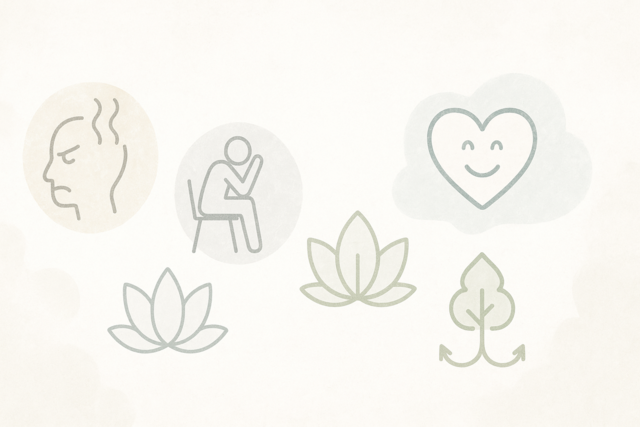Objectives:
This article will outline the mindset and practices that are important to master to ensure you attain the most benefit from using affirmations to heal. These are key elements that can be the difference between marginal and astounding results.
Section 1. Having a Clear Desire to Heal
Have you ever known someone who seemed content with their illness? Not that they were happy with it, but they seemed to have gotten used to the fact that they are out of balance and may even use their illness as a crutch to avoid people and uncomfortable scenarios. Or perhaps they have embodied the martyr complex and feel as if it is their lot and duty to suffer quietly.
For some people, illness has become so ingrained in who they are, that they cannot fathom a life otherwise. It is important before beginning an affirmation regimen, that you take the time to check in with your intention and ensure you are truly ready to let go of your illness.
Here are some questions you can ask yourself:
- How has this illness/problem held me back in my health and overall life?
- How would my life become better if I could resolve this problem?
- What goals and dreams do I hope to accomplish, once I no longer have this illness?
- Am I really committed to moving into a new chapter of my life, although I am not sure what it will bring?
- Do I love myself enough to follow through on this journey, no matter how bumpy and uncertain the road seems?
Asking yourself these probing questions will allow you to gauge your readiness to accept the challenge of healing yourself. When answering the questions, be honest with yourself. Write down your answers and delve more deeply into any negative responses that come up in order to truly understand what may be holding you back. Often, it is just fear of the unknown. Have courage. Taking the road less traveled usually leads to the most beautiful and unexpected places.
Section 2. Having Belief in the Process
Based on what you have learned so far, do you have confidence in the fact that there is a definite mind/body connection? Do you believe you can improve your condition by completing the exercises we mentioned, and using healing affirmations on a consistent basis? If you do not, continuing may be futile.
The mind is an amazing entity. It will literally perform based on your subconscious perceptions and beliefs. If you are excited about the possibilities of this mode of healing and have hungrily absorbed all of the information in this article, your mind will be primed to assist your body in healing. If the opposite is true, then you can do all of the redecorating and chanting you like, but you will most likely have marginal, if any, results.
Take some time to check in with your beliefs. How do you feel about continuing? What are any hesitations you have? Are you worried that, while interesting, this may not work for you? Or are you concerned about what your loved ones may think of this unconventional therapy? Take the time to work through those feelings and understand that nothing ventured is nothing gained.
The great American Industrialist Henry Ford may have stated it best when he said:
"Whether you think you can, or think you can't - you are correct."
So, if you are struggling with the concepts we have covered, take the time to cultivate a "can do" attitude. Have faith in the process and be open to the possibilities.
One of the most important skills to master is the ability to embrace stillness and open your mind and heart to what they are trying to tell you. Often, when we are sick, our bodies have been whispering to us for quite some time. However, since we are constantly over-stimulated and out of touch with our inner self, we rarely pay attention. Over time, the whispers that were ignored turn into a roar and bring with it physical symptoms. At that point, we are wondering what on earth happened! Learning to regularly quiet the mind and look within can help you to catch issues early before they turn into full-blown problems.
Make it an ongoing practice to check in with yourself and your feelings. Use deep breathing, journaling, or any other technique you like to allow your thoughts and feelings to flow out so they do not create any energetic blocks in your body.
Section 4. Consistency
As with anything you hope to master, consistency is critically important to long-term success. It is not just enough to dabble in trying to heal yourself and make a halfhearted attempt. You must commit to integrating the practices described into your life on an ongoing basis. This is the way permanent change occurs. With patience and perseverance, you can greatly improve your condition.
Section 5. Visualization
To be successful in using affirmations, it is important to be able to visualize your desired outcome. The basis of this practice is that you focus on a desired state of being and create healing mantras in the present tense that call that reality into being. If you are unable to imagine clearly what you desire, it will be very hard to visualize it and create affirmations that are likely to help you.
As humans, we thrive off of routine and consistency. It comforts us, even if what is consistently occurring is not good for our health, or in the best interests of our lives, overall. However, the one thing we must realize is that stagnation is not healthy. And to move through obstacles and illness, change is not only important, it is highly necessary.
As you move through the stages of your healing journey, you will encounter instances where you have one of two choices: Try something new that will possibly improve your life, or stick with the safe route, which has brought you what you currently have. It will be scary to step into uncertainty, but taking the risk and exploring new roads brings satisfaction and discovery.
It's also important to be prepared for the various emotions that come with really exploring your inner thoughts, past experiences, and traumas. Allow yourself to feel the emotions of each, fully and without restraint. It is only by fully embracing and working through these emotions that you can safely put them to rest and move to a more serene state of being.
Food for Thought:
Objectives
Affirmations can be crafted through various mediums. In this article, you will learn the different forms an affirmation can take and how each can be effective on its own, or in conjunction with other forms.
Section 1. Written Affirmations
Written affirmations are structured phrases of one or two written sentences that state a clear intention, goal, or release of negativity. They are clear and concise and aid the seeker in encapsulating exactly what they desire. Often, written affirmations can come from random journal entries, meditation sessions and speaking to others about your life. The key is to capture these thoughts and intentions for later use.
Some people keep a separate journal or notepad to document their written affirmations. They may read through them first thing in the morning and last thing at night. Also, many people find it beneficial to write the affirmation many times over, in order to solidify its existence in their mind and in the universe. You can also write specific affirmations in strategic places, so they are visible when you may need a reminder or emotional boost. Turning your thoughts into tangible phrases and sentences helps to make your goals more real and also holds you accountable for not letting them die.
Section 2. Spoken Affirmations
Probably the most popular form of affirmation, this involves speaking an affirmation in an audible voice. This is usually done when alone and in a relaxed setting. The affirmation is most effective if uttered repeatedly and on an ongoing basis. Spoken affirmations are often used after a session of meditating, or when presented with a problem or emotionally upsetting situation. In these cases, quieting the mind, breathing in deep, and speaking an affirmation in a measured and relaxed way can have tremendous restorative benefits.
Spoken affirmations can also be articulated in a group setting where all of the participants are supporting each other in common goals. This can actually be more powerful than saying them to yourself, as you have the collective energy of a group to propel you and hold space for what you are stating.
Examples of this are substance abuse programs, survivor groups, and mastermind support groups. Having a group of people witness your vulnerability in a safe and loving environment, and provide support as you reach for a new reality, is priceless.
Some individuals find they receive more benefit from affirmations when in a deeply meditative state. This may mean using something like candlelight, aromatherapy, or massage to stimulate a highly relaxed state of being in which you find it easy to connect to your thoughts and spirituality. In this state, you can either repeat the affirmation to yourself in your mind, or say them out loud. You may feel called to state the affirmations in a soft whisper, or repeat them more audibly, in the form of a rhythmic chant. Do what feels right for your spirit in the moment.
Often, when in this highly relaxed and suggestive state, one will receive new clarity regarding old problems and issues, and guidance on how to move forward successfully. It is helpful to keep a notebook nearby to record any epiphanies that occur.
Section 4. Colorful/Visual Affirmations
This type of affirmation is perfect for creative types, and those who like bright visual reminders of their goals and dreams. Visual affirmations can take many forms, such as posters, vision boards, t-shirts and artistic projects. These highly stimulating objects serve as a cheerful reminder of what you want to accomplish and spur you on to achievement.
You may find that certain objects aid in relaxing you and allowing your mind to become open to the power of the affirmations. The items may be something as simple as a fresh vase of flowers, or a treasured personal item from a departed relative. Some items that may aid in reaching a relaxed and reflective state may include:
- Candles and incense
- Nature recordings
- Scenic pictures
- Favorite memorabilia from a trip
- Beloved items from childhood
- Enticing fabrics and throw pillows
Each person is different and it is up to you to explore what items allow you to create an optimal environment for meditation and healing. Experiment with a few things and find what feels right. Don't become frustrated if you cannot create the perfect environment immediately. It may take a bit of introspection before you get to know yourself well enough to create the environment that truly feeds your soul. Just do not give up on yourself.
Food for Thought
What type of affirmations seem most comfortable to you? Are you willing to try out different styles to gauge their effectiveness? Also, think of some objects you can introduce into your meditation room or other healing space.
Conclusion



























